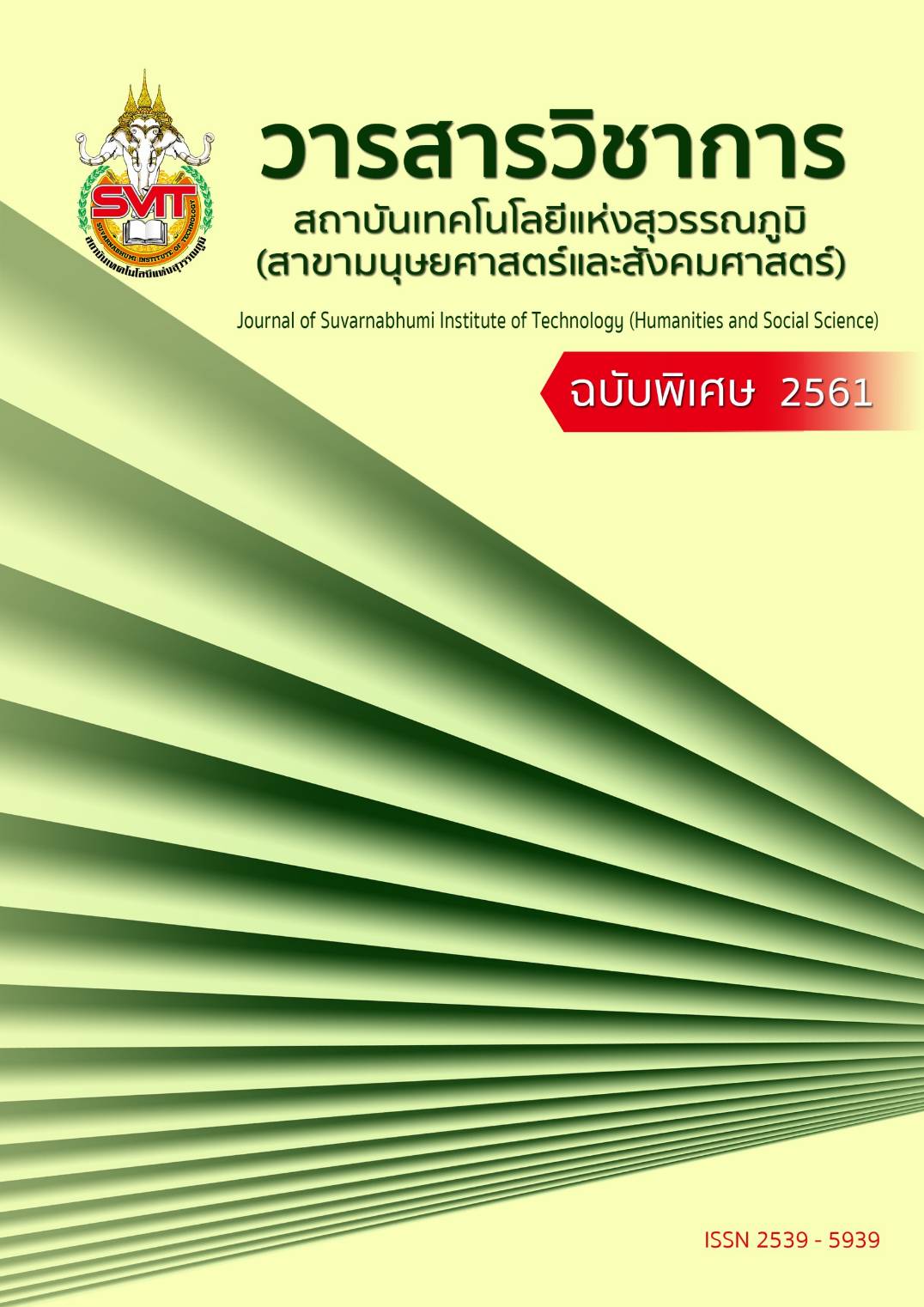SERVICE MARKETING MIX STRATEGIES OF LOW COST AIRLINES IN THAILAND: CASE STUDY OF THAI LION AIR, NOK AIR, AND AIR ASIA
Keywords:
Service Marketing Mix, Low Cost Airlines, Thai Lion Air, Nok AirAbstract
The research of Service Marketing Mix Strategies of Low Cost Airlines in Thailand Case Study of Thai Lion Air, Nok Air, and Air Asia’s objectives were 1) to study the Service Marketing Mix Strategies of 3 Low Cost Airlines in Thailand. 2) To study Thai passengers’ behavior towards the services of Thai Low Cost Airlines at Don Mueang Airport. 3) To study the relationship between the Service Marketing Mix Strategies (7Ps) and Demographic factors. This research was conducted in form of Quantitative Method. The sample size was 400 Thai passengers of Low Cost Airlines: Thai Lion Air, Nok Air, and Air Asia at Don Mueang Airport during January to April 2018. Multi-stage Sampling Method was employed in this research by starting with Purposive Sampling in choosing Thai passengers who used to buy 3 Low Cost Airlines, then Convenience Sampling Method was used in order to get the amount of respondents for this research. The data collection tool was Questionnaires. The statistics for data analysis were Frequency, Percentage, Mean, Standard Deviation, and Chi-square.
The results were founded that most of respondents were men at the age of 26-35 years with the education in Bachelor degree, having the occupation as Government or State Enterprise staffs with monthly income of 15,001-30,000 Baht. In part of Service Marketing Mix Strategies from 3 Low Cost Airlines customers’ perceptions, all 7Ps factors were rated in high level which were Physical Evidence, Price, Promotion, Place, Product, Process and People, respectively. Moreover, the first and the second concerned aspects of each Service Marketing Mix factors were as followed in Physical Evidence factor: in-flight atmosphere and cabin cleanliness, Price factor: clear declaration on airfares/ fees and reasonable airfares/ fees, Promotion factor: having Advertising, Public Relations on various medias and having Call Center, Place factor: convenience and easy in purchasing or airfares enquiry and booking through phone/ website, Process factor: fast and convenience in baggage pick-up and fast and convenience in flight check-in, Product factor: the airlines routes met with customers’ needs and good reputation and image, and People factor: having experienced and good aircraft controlled pilots and good information on inflight staffs and pilots.
Additionally, the research result of Thai passengers’ behavior on Low Cost Airlines: Thai Lion Airlines, Nok Air, Air Asia were founded that the main purpose of traveling was to work/ to attend conference/ to do business at the average of 1-2 times per year. The buying decision was made by the passengers themselves. Lastly, the passengers mostly booked air tickets through Airline’s website. As the result of testing the relationship between the Service Marketing Mix Strategies (7Ps) and Demographic factors (age, gender, occupation, income, and education background) at statistical significant level .01, the customers gave the important level on 7Ps factors that were Promotion, Price, Physical Evidence, Product, Place, People, and Process respectively. In conclusion, the first 3 Service Marketing Mix Strategies that were most concerned by Thai passengers of 3 Low Cost Airlines were 1. Promotion 2. Price and 3. Physical Evidence.
References
กัลยา วาณิชย์บัญชา. (2546). สถิติสำหรับการบริหารและการวิจัย. (พิมพ์ครั้งที่ 7). กรุงเทพฯ: จุฬาลงกรณ์มหาวิทยาลัย.
พงษ์พันธุ์ ตระกูลศรีชัย. (2553). การศึกษาทัศนคติและพฤติกรรมของผู้โดยสารชาวไทยที่มีต่อการใช้บริการสายการบินต้นทุนต่ำ กรณีศึกษา: สายการบินไทยแอร์เอเชีย. บัณฑิตวิทยาลัย มหาวิทยาลัยกรุงเทพ.
พีระยุทธ์ คุ้มศักดิ์. (2555). ความพึงพอใจของผู้โดยสารที่มีต่อคุณภาพบริการของสายการบินต้นทุนต่ำภายในประเทศ. การประชุมวิชาการระดับชาติ เบญจมิตรวิชาการ ครั้งที่ 2. วันที่ 29 พฤษภาคม 2555. ปทุมธานี: มหาวิทยาลัยนอร์ทกรุงเทพ วิทยาเขตรังสิต.
ยุทธศักดิ์ คณาสวัสดิ์. (2547). สายการบินราคาถูกเสริมกลยุทธ์เพิ่มส่วนแบ่งตลาด. วารสารส่งเสริมการลงทุน. 15(1).
สายการบินไทยไลอ้อนแอร์. (2561). [ออนไลน์], เข้าถึงได้จาก: http://www.lionairthai.com/. (2561, 5 มีนาคม).
สายการบินนกแอร์. (2561). ประวัติสายการบินนกแอร์. [ออนไลน์], เข้าถึงได้จาก: http://sites.google.com/nok-air/home. (2561, 20 มีนาคม).
สายการบินแอร์เอเชีย. (2561). [ออนไลน์], เข้าถึงได้จาก: http://th.wikipedia.org/wiki/แอร์เอเชีย. (2561, 5 มีนาคม).
สินีนาถ ปรั่นเปรื่อง. (2554). พฤติกรรมของผู้บริโภคที่มีต่อการใช้บริการสายการบินต้นทุนต่ำภายในประเทศ. บทความวิชาการ เศรษฐศาสตร์อุตสาหกรรม.
สุธี โง้วศิริ, วรรณพร บริพันธ์ และเจษฏา นกน้อย. (2548). พฤติกรรมและความพึงพอใจของผู้ใช้บริการโดยสารทางอากาศภายในประเทศด้วยสายการบินต้นทุนต่ำ: กรณีศึกษาเส้นทางสายการบิน หาดใหญ่-กรุงเทพฯ และ กรุงเทพฯ-หาดใหญ่. รายงานวิจัย. พิษณุโลก: มหาวิทยาลัยทักษิณ.
Downloads
Published
Issue
Section
License
บทความที่ได้รับการตีพิมพ์เป็นลิขสิทธิ์ของวารสารวิชาการ สถาบันเทคโนโลยีแห่งสุวรรณภูมิ
ข้อความที่ปรากฏในบทความแต่ละเรื่องในวารสารวิชาการเล่มนี้เป็นความคิดเห็นส่วนตัวของผู้เขียนแต่ละท่านไม่เกี่ยวข้องกับสถาบันเทคโนโลยีแห่งสุวรรณภูมิ และคณาจารย์ท่านอื่นๆในสถาบันฯ แต่อย่างใด ความรับผิดชอบองค์ประกอบทั้งหมดของบทความแต่ละเรื่องเป็นของผู้เขียนแต่ละท่าน หากมีความผิดพลาดใดๆ ผู้เขียนแต่ละท่านจะรับผิดชอบบทความของตนเองแต่ผู้เดียว





